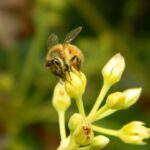Trekking across the Arctic tundra and crossing ice-blue fjords, setting up camp in sub-zero temperatures and staying vigilant for polar bears is just a typical research day for paleoclimatologist Sarah Crump.
Crump is a PhD student with the Institute of Arctic and Alpine Research (INSTAAR) at the University of Colorado Boulder in the US. She is investigating how plant communities on Baffin Island in northern Canada have responded to climate change through time, as far back as 10,000 years ago.
Most of Baffin Island lies above the Arctic Circle, an area known as the world’s ‘climate change barometer’. Crump’s research involves drilling down into lake beds on the island and extracting cores of mud that contain ancient plant DNA. By analysing the DNA in these sediment cores, Crump can determine what grew in the Arctic at a particular time and in what climate.
“While the whole Earth is currently warming inexorably, Arctic temperatures are skyrocketing. The Arctic is expected to warm about twice as much as the rest of the planet by the end of this century,” says Crump.
“We can peer into the past to learn how Arctic ecosystems have responded to past warming in order to predict what will happen as the Arctic warms rapidly now and in the future.”

In stark contrast to the Arctic, Crump travelled to the balmy climes of Perth in January to work with Professor Michael Bunce at Curtin’s Trace and Environmental DNA (TrEnD) lab to process the plant DNA from her lake sediment cores.
“It seems a little crazy because I work in the Artic and Perth is about as far away as you can get from there!” Crump says. “But the TrEnD lab is fantastic. There aren’t many labs in the world that can process ancient DNA as well as it can.”
To separate plant from other DNA in the sediment cores, Crump uses special assays that only bind to plant DNA. She selectively amplifies these and uses a sequencing instrument to identify the base pairs that make up each DNA fragment.
“What we then do is compare all these DNA base pairs to a reference database and then you get your results of what plant taxa were around the lake at that time.”

Crump and her colleagues have so far identified a range of typical Arctic tundra shrubs, berries, aquatic grasses and other vegetation that grew during the last glacial cycle.
“Around 7,000 years ago on Baffin Island following the last glaciation, glaciers were retreating and it was warmer. We can see when certain plant species show up, including woody shrubs that were important to the ecosystem then. Everything we’ve found looks similar to Arctic ecosystems today.
“One plant that we’re really interested in is dwarf birch. It’s expanding northward as the climate warms and is changing Arctic ecosystems in major ways. By studying how dwarf birch responded to past warm periods, we hope to be able to better predict how plant communities will change as the Arctic continues to warm.”

Crump’s research is supported by the National Science Foundation and the National Geographic Society, and her work at the TrEnD lab was facilitated through a grant partnership between Curtin and the University of Colorado Boulder.
“Not many people in my subfield are doing this kind of work yet, I think it’s going to be a big part of the future about how to do things. It’s really fun to be on the leading edge of this research by coming to Curtin and working in a forward-looking lab.”
When Crump’s not trekking across the Arctic or working in the lab, she helps to run a Women in Science and Engineering group at her university, and also advocates for better communication of science outside the academic realm.
“It’s really easy to get sucked into the ivory tower mentality of research. We can talk amongst ourselves but we need to do a much better job of letting the public know what we’re doing and why it matters. It makes us more accountable and drives us to work on problems that are relevant,” explains Crump.
“It will also help improve trust between the public and science which, at least in the US, is a hot topic right now. There’s a lot of distrust of climate scientists in the US, and we need to work on those relationships if we’re going to be turning our research conclusions into policy action, which is one of the main goals when you’re working on something like climate change.”
Learn more about Sarah Crump’s Arctic research.



